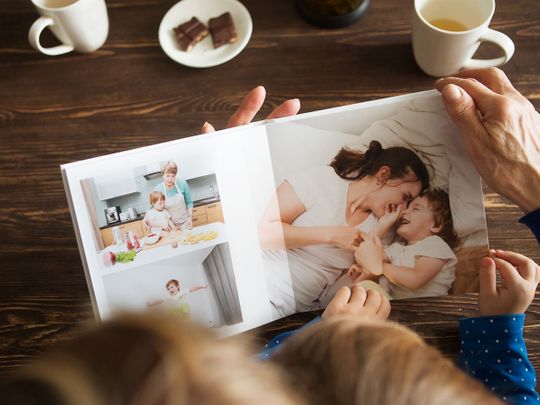A photograph can help you become a better parent
To be a more conscious parent, you may need to confront your own past. One way to do this is to use old photos.
“There are different ways to trigger childhood memories. It can be smells, sounds, places, photographs, etc. “, explains Bene Katabua, educational psychologist at the Intercare health center in Abu Dhabi.
“In psychotherapy, we recognize the need to create safe spaces for people to explore the effects of our childhood. Having these sensory memories can open up a world of memory – both positive and negative. However, since relying solely on memory is not always completely reliable, it can sometimes be easy to invalidate it. Store special items, photographs, keepsakes, journal entries, ticket stubs, etc. can help not only to access memory, but also to validate that certain events have occurred,” she adds.
Why do we bury old memories?
As life goes on and memories pile on top of each other, chances are the oldest ones will fade. Plus, there’s the fact that the brain tends to add more recall value to traumatic times than to happy times. This could be an evolutionary development, according to a 2007 study published in the peer-reviewed journal “Current Directions in Psychological Science.” Researchers say negative emotions such as fear and sadness trigger increased activity in the part of the brain related to memories. These emotionally charged thoughts are retained in greater detail than happy or more neutral memories, but they can also be subject to greater distortion, explains an article on Web MD.
Some people remember their childhood years fondly and remember events with distinct details, while others often comment that they don’t remember particular childhood experiences. In some cases, the lack of childhood memories may be linked to negative childhood experiences in which the brain suppresses certain traumatic details to preserve itself.
– Bene Katabua
Masking can also be a defense mechanism. “Some people remember their childhood years fondly and remember events with distinct details, while others often comment that they don’t remember particular childhood experiences. In some cases , the lack of childhood memories may be related to negative childhood experiences in which the brain represses certain traumatic details to preserve itself.In other cases, the forgetting of early childhood memories is typical because the storage and memory retrieval develop over time,” says Katabua.
The memories we have – whether in a subconscious or conscious space – are what determine how we navigate through life. “We reflect what has been familiar to us since our childhood; what we learned from our childhood, we will project into our current reality. It’s generational trauma,” says Luz Maria Villagras S., mindful parenting coach, hypnosis therapist and neuro-linguistic programming practitioner based in the United Arab Emirates.
The past shapes our future
“Although we don’t have verbal memories of particular events, the body tends to keep track of our early childhood memories. We recognize this in our patterns – whether in relationships, coping mechanisms , recurring illnesses, etc. Our bodies often find ways to repeat certain memories or repress them. None of these are particularly helpful, and attempts at healing should be made instead of the alternatives presented above” , adds Katabua.
The good news is that some generational transmissions are actually positive. “When you see photos from your childhood, if they are good memories, it will help you remember the good times. You remember the times [you may have forgotten]“says Maria Villagras S. This has a mood-enhancing effect. “But the most interesting thing isn’t the image itself, it’s its meaning and the lessons it holds.”
If, for example, says Maria Villagras S., you find a photo of you with your grandmother, you may remember the time you spent with her, the love you had for her and you can use the photo to introduce your little one to those family values of respect and gratitude.
You may remember that when you were a child and your mother did certain things for you, they made you happy. But it was you. But now you have a child. He or she is unique. You can do the same things your mom did and expect her to react the same way, but that’s not you. They have their personality and their needs.
-Maria Villagras S
Certain photographs can also bring closure to a conscious parent. “So you might remember when you were a kid and your mother did certain things for you, they made you happy. But that was you. But now you have a kid. He or she is unique. You can do the same things as your mother and expect her to react the same way, but that’s not you. They have their personality and their needs.” Keeping an open mind while engaging in the memory recall can help you connect the dots and thus be a more present and aware parent.
How to use a photograph to reconnect with your past
To understand where your strategies come from, you need to dive into the past to analyze your childhood. Jasmine Collin, a conscious parenting coach based in Dubai, offers the following exercise to get to know yourself better:
1. Make sure you feel safe and will not be disturbed before doing this brainstorming exercise.
2. Make yourself comfortable, dim the lights and turn off your phone.
3. Have a pen and paper ready to keep your journal and a picture of yourself as a young child.
4. Sit down and look at the photo for three to five minutes.
5. Imagine what it was like to be that child.
6. Now answer these questions:
- What was it like growing up for this child?
- How did he feel growing up?
- What do you wish your parents knew about you back then?
- What needs were your parents not meeting?
- What more did you need?
- If you could change one thing about your childhood, what would it be?
Once you have these answers, you know what negatives to look for in your own behavior and the shadow that hangs over your parenting style. You can then choose to keep it or get rid of it.
A word of warning if you had a rough childhood. “If,” says Collin, “you have a history of physical or emotional abuse, I strongly recommend that you do not do this exercise alone and seek out a qualified therapist.”
If you have a history of physical or emotional abuse, I strongly recommend that you do not do this exercise alone and seek out a qualified therapist.
– Jasmine Collin
The process of learning your memories and triggers can be difficult, but it can also be healing. “The memories that are triggered may not always be positive, but processing them can induce a feeling of healing and closure. In some cases, the memories evoked can be joyful and warm, and can be used as motivation toward a goal to find ways to rekindle similar feelings in adulthood. Either way, having the ability to look back can have a huge effect on our ability to move forward,” Katabua adds.
When you know your own triggers, the weight of a child’s behavior will stop justifying rage and discontent. You will be able to see him for what he really is – just a kid being a kid. The cycle of generational transmissions of trauma will be broken.
Do you have a topic you would like us to cover? Email us at [email protected]



Comments are closed.